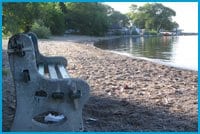Toronto has beaches. Ten of them at the city’s southern edge, from Marie Curtis Park East Beach in the west to Rouge Beach in the east. And, of course, there’s Hanlan’s Point, the Toronto Island beach, which has a stretch set aside for clothing-optional frolicking. Our beaches should be sites of promiscuous socializing, where Torontonians can partake in the beach culture enjoyed by other beach cities worldwide. That includes showing off and ogling bodies, cruising, chatting people up and building new friendships. “Let’s go party at the beach” should be an important part of our vocabulary.
The current situation
On any given summer day, most of the water at our beaches is too infested with bacteria for swimming, caused in part by the fact that much of the city’s stormwater and sewage is collected in the same pipes. That means that during a storm, Lake Ontario gets polluted.
Even without worrisome E coli levels, most of the city is disconnected from its beaches and its waterfront in general. To get to the beach, one has to traverse a wasteland of abandoned industrial factories, disused rail lands and, of course, the Gardiner Expressway. Once you reach it, it’s free to enjoy since it’s mostly publicly owned.
The Toronto Waterfront Revitalization Corporation (TWRC), established in 2000 as a joint venture of all three levels of government, is responsible for rebuilding Toronto’s waterfront into a residential and recreational area with easy access and green space. This month’s Quay To The City event showcased the proposed changes to the Queen’s Quay area, including a green strip and the completion of the Martin Goodman bike trail, and a preview of where 100,000 residents will live.
What it doesn’t address is the question of the actual beaches themselves. Cleanliness, good urban design and a light touch by the police with regard to consensual sexual activity would make them so much more attractive.
Other cities
The shining example of beachfront revitalization is Barcelona. Between 1975 and 1985, the Spanish city went through an economic crisis, with industrial sections along the waterfront drying up. The city used the opportunity to buy up much of this land. When Barcelona was awarded the 1992 summer Olympics, the city moved to develop its Mediterranean property.
The result was the creation of a new beach, a reconfigured expressway system, public promenades and new residential neighbourhoods. The city went from half a mile of developed waterfront to three miles.
In San Francisco, after the 1989 earthquake destroyed part of the Embarcadero Freeway, the city decided to remove the whole expressway, replacing it with a waterfront boulevard.
In Chicago, which has the same length of waterfront on Lake Michigan as Toronto has on Lake Ontario, the city developed a park system from one end to the other featuring museums and other cultural attractions.
Many European cities are known for their topless and nude beaches. The best-known equivalent in Canada is probably Vancouver’s Wreck Beach, where nudity and pretty much anything else goes, including gay sex in the bushes.
Naked-friendly Hanlan’s Point probably remains a mystery to most Torontonians, although not to the gay men who complain that its increased public use has destroyed its attractions as a cruising site.
Hanlan’s is often crowded on weekends while the city’s other beaches remain sparsely populated. Obviously, its sexually charged reputation does it some good.
The future
It’s unclear what the TWRC has in mind specifically for the beaches; no one from the TWRC returned a request for an interview by press time. However, city council adopted a motion in April put forward by councillor Sylvia Watson for various municipal, provincial and federal agencies to study the revitalization of Toronto’s beaches.
Toronto clearly lacks two of Barcelona’s major advantages: Lake Ontario is not the Mediterranean and thus far, Toronto has no Olympics to spur that sort of major beach redevelopment. As far as Europe’s nude beaches go, city councillor Kyle Rae says it’s part of Toronto’s history and is popular now, but may not make a widespread return anytime soon.
“Prior to 1932, all beaches were allowed to be nude beaches. Victorianism was slow in getting to Toronto, I think. Clearly, Hanlan’s Point and the nude — I mean the clothing-optional — beach has been a great success. It’s crowded every weekend. But should it be on the main beaches? That may be something for the study to look at.”
Rae mentions the Gardiner Expressway as a major hurdle to real enjoyment of the beaches. But plans to either destroy it entirely or submerge it have thus far foundered on the exorbitant cost of such a project.
Rae also points out that even without the Gardiner, the realities of living on a lake as opposed to an ocean may put European beach living beyond Toronto’s reach.
“The relationship between the city and the water has been disturbed with the industrial port between us, the pier walls, the breakwaters. I’m not sure we can achieve a beach at the foot of Yonge or John or Jarvis.”
Rae says the reality is Toronto will probably end up with a waterfront more closely resembling Chicago than Barcelona. And while that may not be as fun or sexy as the Spanish beaches, Rae says it will be an improvement.
“It may not be beach per se, but it will be parkland and open spaces, which are just as important.”



 Why you can trust Xtra
Why you can trust Xtra


